written and photographed by Mary L. Peachin
Feb 2003, Vol. 7 No. 5
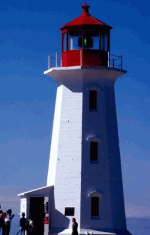 Historic Halifax, founded in 1749, is more than just a watery gateway destination along the scenic shores of the North Atlantic coast. The city’s strategic geographical location played an important role in history, not only dating back centuries, but also more recently during the tragedy of September 11th.
Historic Halifax, founded in 1749, is more than just a watery gateway destination along the scenic shores of the North Atlantic coast. The city’s strategic geographical location played an important role in history, not only dating back centuries, but also more recently during the tragedy of September 11th.
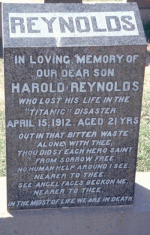 In September, the city was experiencing the height of its tourist season and hotel rooms were sparse. Halifax agencies and residents (pop.360,000) stepped forward to assist 10,000 passengers on 42 inbound European flights that had been rerouted and directed to land in Halifax. For almost a week, stranded passengers were welcomed as houseguests by Haledonians. Halifax Tourism, the Army, and other government agencies worked around the clock. Jonathon Tom sales manager of Tour and Travel for Destination Halifax said “we had more volunteers than we knew what to do with. We housed, fed, then notified our guests when their flights were departing.”
In September, the city was experiencing the height of its tourist season and hotel rooms were sparse. Halifax agencies and residents (pop.360,000) stepped forward to assist 10,000 passengers on 42 inbound European flights that had been rerouted and directed to land in Halifax. For almost a week, stranded passengers were welcomed as houseguests by Haledonians. Halifax Tourism, the Army, and other government agencies worked around the clock. Jonathon Tom sales manager of Tour and Travel for Destination Halifax said “we had more volunteers than we knew what to do with. We housed, fed, then notified our guests when their flights were departing.”
 Their kindness during the tragedy was a historic repeat. When the ill-fated Titanic steamed full speed into an iceberg on April 15, 1912, the boat sunk in waters 700 nautical miles from Halifax. Recovered bodies were brought to the city for burial. Victims were laid to rest in Fairview Lawn, Baron De Hirsch and Mount Olivet cemeteries. The gravestones were numbered according to the sequence of their recovery. The Maritime Museum of the Atlantic has many of the Titanic’s artifacts on display.
Their kindness during the tragedy was a historic repeat. When the ill-fated Titanic steamed full speed into an iceberg on April 15, 1912, the boat sunk in waters 700 nautical miles from Halifax. Recovered bodies were brought to the city for burial. Victims were laid to rest in Fairview Lawn, Baron De Hirsch and Mount Olivet cemeteries. The gravestones were numbered according to the sequence of their recovery. The Maritime Museum of the Atlantic has many of the Titanic’s artifacts on display.
During World War I, Halifax’s port was a hub of activity. Early in the morning of December 6, 1917, the French ship Mont Blanc, loaded with 2,300 tons of wet and dry picric acid, 200 tons of TNT, and 35 tons of highly explosive benzyl collided with the Norwegian vessel Imo. The explosion was said to have emptied the harbor. Seven crew members died, but the disaster destroyed more than 1600 homes raising the death toll to more than 1700 victims. It was the largest man-made explosion until the explosion of the atomic bomb.
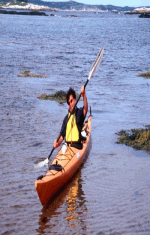 From the twenties to the seventies, Pier 21 operated in a similar capacity to Ellis Island or San Francisco’s Angel Island. It served as Halifax’s immigration processing center for wartime evacuees, refugees, troops, war brides and their children. 1,000,000 people or 20% of all Canadians including the military passed through Pier 21.
From the twenties to the seventies, Pier 21 operated in a similar capacity to Ellis Island or San Francisco’s Angel Island. It served as Halifax’s immigration processing center for wartime evacuees, refugees, troops, war brides and their children. 1,000,000 people or 20% of all Canadians including the military passed through Pier 21.
Today, overlooking the city, the star-shaped Citadel is one of Britain’s 19th century fortifications. Young men and women dressed in costume play Tartan tunes on bagpipes prior to the daily ceremony of the noonday gun. The 12-gauge cannon has a smooth bore muzzle, and is front-loaded with a rammer containing one pound of gunpowder. Originally used to signify the daily meal, the cannon explosion today is strictly ceremonial.
 Parks Canada has preserved this site where 800 men were stationed in 1869. Visitors can walk through the ditch-like moat (without water) into the grounds of the fort. Barracks were sparse with only six percent of the men allowed to marry. Wives shared the single cot and their children slept on the floor underneath. A single bucket served a dual purpose. It was used as a toilet then rinsed for washing. The Citadel was never attacked by enemy fire.
Parks Canada has preserved this site where 800 men were stationed in 1869. Visitors can walk through the ditch-like moat (without water) into the grounds of the fort. Barracks were sparse with only six percent of the men allowed to marry. Wives shared the single cot and their children slept on the floor underneath. A single bucket served a dual purpose. It was used as a toilet then rinsed for washing. The Citadel was never attacked by enemy fire.
Today, this history blends with a bustling waterfront. The tall ship Silva raises her sails as she motors for an hour and half along the water. The fun-filled narrated tours on a LARC (Light Amphibians Resupply Cargo) amphibian descends down a ramp into the waters of the port. The boat follows the waterfront then exits to pass by interesting sites in the city. Our personable guide Suzie had us “ribbeting” (the company’s logo is a frog) as passerby’s gawked at us.
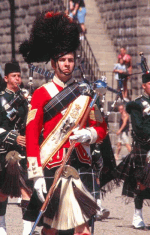 The same type of personalities lit up the tour of the Keith brewery. We were taught about the quality of Mr. Keith’s hops and barley while seated in his formal dining room. “Mr. Keith is running late” we were told as we learned about the quality of his beer while waiting his arrival. Long deceased, the costumed narrators took us through the copper vats before serving up steins of beer in the pub and game room.
The same type of personalities lit up the tour of the Keith brewery. We were taught about the quality of Mr. Keith’s hops and barley while seated in his formal dining room. “Mr. Keith is running late” we were told as we learned about the quality of his beer while waiting his arrival. Long deceased, the costumed narrators took us through the copper vats before serving up steins of beer in the pub and game room.
Whale watching boats depart daily in search of Harbor and Gray seals, shy pinnepeds that can stay submerged for as long as 20 minutes, and whales. The most commonly sighted whales are Minke and Humpback. We searched in vain for waterspouts, feeding seabirds or the telltale fins, but were disappointed. We were told a nuclear submarine had recently exited the harbor scaring away the whales.
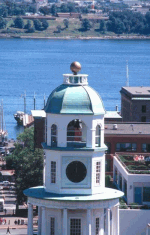 One highlight of our visit along the North Atlantic was kayaking with ECO (East Coast Outfitters) in Lower Prospect. Scott Sanford’s boathouse is located about 30 minutes south of Halifax. We paddled 17.2-foot double Dagger kayaks through a back bay passing Shannon and Betty Island as we made our through Norris Gut for an hour’s journey to Mosher Island. Landing on an isolated beach, we hiked a small trail, stopping to pick blueberries, as we made our way to a picnic site. There we sat on glaciated boulders overlooking the sea snacking on fresh watermelon. Eco also offers lobster boil trips. After the first freeze, Scott collects the cranberries lining the trail. After boiling them, he adds rum, serving his guests “Cranberry Yum.” Soon it was time to go after a brief tour of the Lower Prospect village.
One highlight of our visit along the North Atlantic was kayaking with ECO (East Coast Outfitters) in Lower Prospect. Scott Sanford’s boathouse is located about 30 minutes south of Halifax. We paddled 17.2-foot double Dagger kayaks through a back bay passing Shannon and Betty Island as we made our through Norris Gut for an hour’s journey to Mosher Island. Landing on an isolated beach, we hiked a small trail, stopping to pick blueberries, as we made our way to a picnic site. There we sat on glaciated boulders overlooking the sea snacking on fresh watermelon. Eco also offers lobster boil trips. After the first freeze, Scott collects the cranberries lining the trail. After boiling them, he adds rum, serving his guests “Cranberry Yum.” Soon it was time to go after a brief tour of the Lower Prospect village.
After stopping briefly at an abandoned red and white lighthouse high on the granite cliffs at Chevucto Head, we saw remnants of bunkers that once guarded the harbor to Halifax.
It’s true. Halifax is a major portion of “Canada’s Ocean Playground, but the modern city is one that also includes a, fascinating history and days of fun-filled tours and adventure.
If you go:
Halifax Tourism www.halifaxinfo.com Destination Halifax www.destinationhalifax.com Nova Scotia Museum museum.gov.ns.ca The Maritime Museum of the Atlantic maritime.museum.gov.ns.ca Nature and whale watching tours www.murphyonthewater.com 902-420-1015 Harbour Hopper Tours 902-490-8687 www.harbourhopper.com Pier 21 902-425-7770 www.pier21.ns.ca McKelvie’s Restaurant (902) 421-6161 www.energeticfoods.com Maple Bistro & Wine Bar (902) 425-9100 www.maplerestaurant.com Lord Nelson Hotel 902-423-6331 www.lordnelsonhotel.com Anatolia Turkish Cuisine 902-492-4568 ECO East Coast Outfitters www.eastcoastoutfitters.com 902-852-2567, 2017 Lower Prospect
Nova Scotia’s Cape Breton Island
Written and photographed by Mary L. Peachin
 Nova Scotia license plates proudly proclaim “Canada’s Ocean Playground.” And it’s true. A quilt of green farmland descends into sparkling blue waters of the Northumberland Strait along the Sunrise Trail leading to the village of Pictou. The city, known as “The Birthplace of New Scotland,” is the port where Scottish settlers docked their ship Hector in 1773. This northeastern route to Nova Scotia’s famed Cabot Trail is named for brothers John and Sebastian Cabot, who landed in 1497 near the North Cape on Cape Breton Island.
Nova Scotia license plates proudly proclaim “Canada’s Ocean Playground.” And it’s true. A quilt of green farmland descends into sparkling blue waters of the Northumberland Strait along the Sunrise Trail leading to the village of Pictou. The city, known as “The Birthplace of New Scotland,” is the port where Scottish settlers docked their ship Hector in 1773. This northeastern route to Nova Scotia’s famed Cabot Trail is named for brothers John and Sebastian Cabot, who landed in 1497 near the North Cape on Cape Breton Island.
Country roads cut through red bluffs and fields of flowering meadows drifting into tidal saltmarshes. Leggy cattails in ditches along the road reached up to fields of wild iris and orchids, goldenrod, fireweed, and Queen Anne’s lace. Historic towns are scattered along the roadside where generations of residents still live to harvest the land and sea.
Pictou Lodge, perched above the wind-blown shore overlooking the Northumberland Strait was opened in 1926 as the Wentworth Lodge, a property of the Canadian National Railway.
 We traveled to Nova Scotia to explore the unspoiled natural beauty of Cape Breton Island with its 1,000 square miles of coastal vistas, pastoral landscapes, and wilderness scenes. A single causeway, opened in 1955, connects Cape Breton to Nova Scotia. The relative isolation of Cape Breton Island provides a unique heritage dating back centuries, one of the Mi’kmaq, Scottish and French Acadians cultures.
We traveled to Nova Scotia to explore the unspoiled natural beauty of Cape Breton Island with its 1,000 square miles of coastal vistas, pastoral landscapes, and wilderness scenes. A single causeway, opened in 1955, connects Cape Breton to Nova Scotia. The relative isolation of Cape Breton Island provides a unique heritage dating back centuries, one of the Mi’kmaq, Scottish and French Acadians cultures.
Cape Breton National Park covers 366 square miles along the North Atlantic and steeply traverses four mountains. There are 26 hiking trails and dozens of picnic parks and beaches. Whitecaps, stirred by gusting wind covered St. Georges Bay as we followed the road northward along the Ceilidh (pronounced Ceed-lay) Trail between Port Hawkesbury and Margaree Harbour.
 Ceilidh is the foot stompin’ folk music of the region. The upbeat music features a fiddler, sometimes with dancers, a piano player, an occasional bagpipe or even a musician playing two spoons as rhymnthic and creatively as drums.
Ceilidh is the foot stompin’ folk music of the region. The upbeat music features a fiddler, sometimes with dancers, a piano player, an occasional bagpipe or even a musician playing two spoons as rhymnthic and creatively as drums.
In Glenville, the Glenora Inn and Distillery serves pub fare, but the attraction is the Ceilidh music and tours of the single malt whiskey distillery.
1500 foot Sugarloaf Mountain separates two Margaree valleys in the interior of the island. The Portree hiking trail parallels the bank of the Northeast Margaree River, a fishery for Atlantic salmon during spring and the fall migrations. A 5-mile trail winds through a spruce, many with huge burls, and birch forest scattered with flowering meadows.
Hermann and Ruth Schneeberger, their two toddlers, and Cressie, a black lab, own the Big Intervale Fishing Lodge, a cozy Swiss-type chalet with six rustic guest cabins. Part-time server and bartender Cindy Macleod yarned tales of working as a chef on North Atlantic oil rigs. As dinnertime approached, I asked where Hermann got his trout. “From the pond in the back.” A few minutes later, fly rod in hand, I caught two speckled trout for our dinner.
 Since the early 1900s, Chéticantians have farmed the northern reaches of the Cabot Trail coastline (which continues around the island to Baddeck), raised cattle, and fished for a living. Acadian villagers fished for the Robin family until 1911 when Matthews & Scott set up a competitive company that paid the fishermen with cash. The result was the creation of the first fish marketing co-op in North America.
Since the early 1900s, Chéticantians have farmed the northern reaches of the Cabot Trail coastline (which continues around the island to Baddeck), raised cattle, and fished for a living. Acadian villagers fished for the Robin family until 1911 when Matthews & Scott set up a competitive company that paid the fishermen with cash. The result was the creation of the first fish marketing co-op in North America.
On a Sunday afternoon townfolks, who primarily speak French, gathered around tables in the Doryman Beverage Room {read pub} drinking beer and stomping their feet as they listened to Acadian fiddlin’ music. Cheticamp is also the northern entrance to Cape Breton National Park. But, this great location, overlooking the North Atlantic, is its claim to fame.
One of the more popular trails, about 15 minutes into the highlands of Cape Breton Park, is the 5-plus mile Skyline Trail. Meticulously groomed and edged by rocks, the trail has wooden planks crossing eroded areas and boardwalks covering wet boggy areas leading down the fragile heather-covered ecosystem to the ocean. One of several trail signs demonstrated moose stripping leaves and bark of the surrounding groves of birch trees. It seemed unlikely until we encountered a moose and calf busily gorging on trees along the trail.
 Most of the coastal villages offer whale-watching tours. Some guarantee a 100 % sighting guarantee or your money back. We chose to drive an additional 16-miles to Bay St. Lawrence for our whale watching tour.
Most of the coastal villages offer whale-watching tours. Some guarantee a 100 % sighting guarantee or your money back. We chose to drive an additional 16-miles to Bay St. Lawrence for our whale watching tour.
The Northern Gannet I is operated by Captain Dennis Cox. The most frequent sightings include the white-sided dolphin, minke, pilot, and finback whales. Pilot whales have teeth used to grab and not chew food. These smaller whales average about 26 feet and weigh four tons. The Minke, which are baleen or filter feeders, weigh about 10 tons, travel alone, and are fast swimmers. Cox searched the horizon for white Gannet birds diving for herring and mackerel to help him locate whales.
Double-breasted cormorants, Hermann and black gulls lined the seawall of the port as we headed into the Cabot Channel. A minke whale surfaced several times before eluding us. An Ocean Sunfish (Mola Mola), its oblong body with small mouth, high rudder-like dorsal and anal fins, and no caudal (rear) fins scooped jellyfish as it swam tilted in the water. Cox has seen as many as 300 whales during a trip, but this was not one of those days in spite of spotting many schools of bait fish (a meal which usually attracts the whales) on his fish finder.
Before the turn of the century, Alexander Graham Bell brought his friend Henry Clay Corson from Akron, Ohio to Nova Scotia by horseback. Riding along steep narrow cliffs to Ingonish, Corson fell in love with the peninsula, bought some land, and built a summer home for his wife. He continued over the year to buy adjacent land from fishermen. After his death in the 40s, his land became what is now known as the Keltic Lodge, a stately property owned by the Government of Nova Scotia.
 The two and a half-mile Middle Head trail offers scenic views of inlets along the peninsula. The trail begins at the resort and ends at the point. A Stanley Thompson’s Highlands Links golf course is about a five-iron from the lodge.
The two and a half-mile Middle Head trail offers scenic views of inlets along the peninsula. The trail begins at the resort and ends at the point. A Stanley Thompson’s Highlands Links golf course is about a five-iron from the lodge.
An alternative to catching a ferry directly to St. Ann’s is to follow the road as it weaves around St. Ann’s bay. The route is called the Artisans loop and features homes with studios featuring pottery, ironwork, quilting, glass works, homemade jams and maple syrup, and other crafts.
In Baddeck, Parks Canada has established a historic site to Alexander Graham Bell and his wife Mabel, two of their beloved heroes. The Bells spent 37 years living along the shoreline of Bras D’Or Lake. While Bell was famous for his invention of the telephone, the museum also features his work in bridging the world of the deaf, experiments with kites, hydrofoil boats, airplanes, and the treadle-powered graphophones.
Leaving Cape Breton, again crossing the Canso Causeway, we followed the Marine Trail as we made our way back to Halifax.
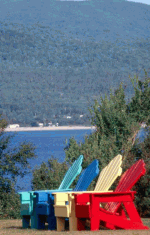 More than a century ago Mi’kmaq Chief Lone Cloud owned the land now known at Liscombe Lodge. A gold mine boomed at the turn of the century before several mills prepared lumber for shipment down the Liscomb (spelled with an e) River.
More than a century ago Mi’kmaq Chief Lone Cloud owned the land now known at Liscombe Lodge. A gold mine boomed at the turn of the century before several mills prepared lumber for shipment down the Liscomb (spelled with an e) River.
32 tons of mussels were harvested last year from nearby Spanish Bay. Bags are attached to buoys lined in the water. It takes a year and a half for them to grow to size for harvesting.
Over a period of six days, we drove more than 600 miles traveling from Halifax around the northern part of Cape Breton Island. Every bend in the road held another scenic vista: a boat-filled cove, a red and white lighthouse, a high steeple white-painted church surrounded by faded tombstones of the cemetery, a colorful house with stacked lobster traps. Wild flowers bloomed everywhere, folks were friendly, many just sitting on their porches enjoying the day. Nova Scotia is truly idyllic.
Pictou Lodge Resort (888) 662-7484 www.MaritimeInns.com Glenora Inn and Distillery (800) 839-0491 [email protected] or www.glenoradistillery.com Big Intervale Fishing Lodge Margaree Valley (902) 248-2275 [email protected] or www.capebretoNet.com/Margaree/fishinglodge/ Laurie’s Motor Inn (800) 959-4253 [email protected] or www.lauries.com Keltic Lodge Middle Head Peninsula Ingonish Beach (902) 285-2880 or (800)565-0444. www.signatureresorts.com Liscombe Lodge Liscomb Mills (902) 779-2307 www.signatureresorts.com Captain Cox’s Whale Watch (902) 383-2981 or (888) 346-5556 Alexander Graham Bell National Historic Site Baddeck (902) 295-2069 www.parkscanada.gc.ca
